I want to start by telling you about my theater son. He’s diagnosed with pervasive development delays. He’s not autistic. He has many difficulties that may infringe on his ability to be independent. He was born two months premature. Maybe that has something to do with it. There’s also a lower intelligence factor in his family of birth. It may all contribute as well as his rough first couple years with his birth family.
When he came to live with us at 2.5 years old, he didn’t have many words he 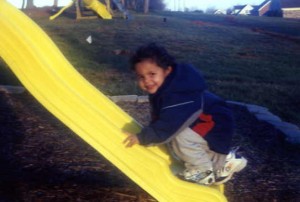 knew or understood, let alone pronounce where he could be understood. As I got to know him, I realized that he was a strong right-brained learner. But, the clincher was that he had difficulties in right-brained areas! So, he was a right-brained learner without the capacity to express himself well in a right-brained manner.
knew or understood, let alone pronounce where he could be understood. As I got to know him, I realized that he was a strong right-brained learner. But, the clincher was that he had difficulties in right-brained areas! So, he was a right-brained learner without the capacity to express himself well in a right-brained manner.
I worked on language throughout his day incidentally, but I particularly focused on developing right-brained skills: play and imagination, block design and manipulation, drawing and coloring. He had limited skills in these areas. He had limited skills with left-brained things, too. He was a child with seemingly no strengths. Instead of concentrating on building the areas that were in his non-strength area, though, I wanted to start with what was supposed to be his strength area. Somehow, I knew those might develop more quickly with support.
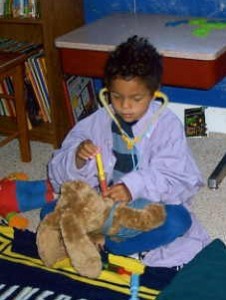 Slowly, he was able to feel some confidence in right-brained things that eventually he fell in love with. For instance, though he needed help learning to play, once he knew how and especially once he knew how to do pretend play, he fell in love with it, thus, why I call him theater son. He’s in a costume every day at minimum. I remember when we first helped him learn to color, craft, and draw. He resisted because of his lack of complete ability. He literally needed hand over hand with it. But, as he grew competent, he fell in love with it.
Slowly, he was able to feel some confidence in right-brained things that eventually he fell in love with. For instance, though he needed help learning to play, once he knew how and especially once he knew how to do pretend play, he fell in love with it, thus, why I call him theater son. He’s in a costume every day at minimum. I remember when we first helped him learn to color, craft, and draw. He resisted because of his lack of complete ability. He literally needed hand over hand with it. But, as he grew competent, he fell in love with it.
So, why do I tell this story? My theory is similar with Asperger’s and right-brained learning. First of all, boys are more prone to being right-brained. Girls are more prone to being left-brained. There are more boys than girls who are Asperger’s/autism spectrum. Taking my builder son as an example because he is high functioning autism (not Asperger’s … there is a difference): Whenever he takes the on-line right-brained/left-brained tests, he almost always tests as left-brained. He’s not. He’s very much right-brained. However, the autism features bring in left-brained attributes.
The most notable left-brained attributes for those on the spectrum are predictability, thus schedules and order and timeliness. For instance, though most of my typical right-brained children were oblivious to time, my builder son was very aware of time. But, he was also gifted in spatial strengths … or his place in space … which is what more right-brained people are better at.
Compare this same exception to female right-brained people. The female gender is linked with several left-brained attributes. My daughter is right-brained, but she has left-brained attributes contributed by her female gender, such as organization skills, word-based abilities, and liking to learn math in a left-brained way. But the majority of how she relates to the world is right-brained.
Though my builder son lacked typical play skills and imaginative skills when he 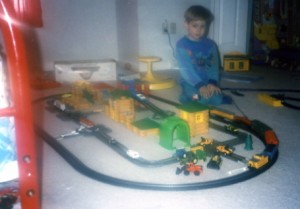 was younger, he had his own version of imaginative play and he often is “lost inside his own world in his head.” His disconnect with the world is often associated with his extreme draw to what is formed inside his mind. Also, I think most think in pictures, like Temple Grandin shared. That’s definitely right-brained.
was younger, he had his own version of imaginative play and he often is “lost inside his own world in his head.” His disconnect with the world is often associated with his extreme draw to what is formed inside his mind. Also, I think most think in pictures, like Temple Grandin shared. That’s definitely right-brained.
Another huge element of being right-brained is being emotion based. Some will say that those on the autism spectrum lack emotion. I disagree. It’s released in a different way because of the autism element. So, I’ll use two different sons with autism. One son has always been very “behavioral.” That’s his emotion release representation. When he couldn’t communicate, he would melt down. When others are being behavioral around him, he’d melt down.
What I hear from a lot of highly sensitive right-brained people is that they can feel other people’s emotions. My right-brained daughter (who represented with a lot of autism traits before age 12) doesn’t have that attribute. What she does is when she feels negative emotion, it triggers her emotion house (what I decided to call it), and anxiety appears. That’s what my builder son with autism is like. He didn’t melt down or outburst, he would get anxious. The more emotion around him, the more anxious he would become.
On the flip side, my daughter shared with me that thinking of her stories was a trigger for feel good emotions. At that very same moment, one of my sons with 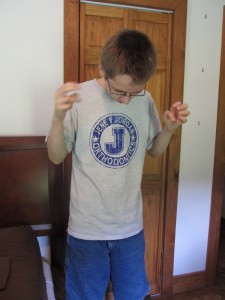 autism was walking around, “stimming,” and thinking in his head and smiling and feeling very happy. He was thinking his autistic thoughts to release feel good emotions. He enjoys his inner life because it’s a reliable and primary source for feel good emotions. My daughter shared how she felt the same way about her inner life stories she thought of throughout the day and throughout most of her childhood and teens years. It was her safe place and the way she could most feel good emotions. I believe my builder son is the same way.
autism was walking around, “stimming,” and thinking in his head and smiling and feeling very happy. He was thinking his autistic thoughts to release feel good emotions. He enjoys his inner life because it’s a reliable and primary source for feel good emotions. My daughter shared how she felt the same way about her inner life stories she thought of throughout the day and throughout most of her childhood and teens years. It was her safe place and the way she could most feel good emotions. I believe my builder son is the same way.
Balancing the emotional needs for someone on the spectrum looks different than other people. Because of the disconnect with understanding the world they live in, this “emotion trigger” of being in the world can trigger the emotion house into anxiety. Many of them may counter that by consistently initiating their feel good emotions by engaging in their autism-based imaginative thinking world (autism-based or not) or a positive (to them) sensory experience. This helps them handle the times they interact with the world that is often a bit confusing which triggers negative feelings from their emotion house, resulting in a meltdown or explosion (especially when they’re younger), to anxiety and stress (especially when they’re older). But, the core is emotion-based thinking, and that is right-brained. Living with autism and the changes to the brain that entails causes this to look differently.
Many of the perseverative interests of those on the spectrum, especially those who have Aspergers and high functioning autism, are in the creative outlet arena. Ceiling fans is electronics, trains and building tracks is spatial, LEGO is building, and even my more affected son’s interest in the alphabet and numbers was because of the patterns, which is right-brained.
Let’s recap all the autism-related attributes with those that are also right-brained attributes:
- Imaginative thinking
- Thinks in pictures
- Creative outlets through perseverative interests
- Sensory-based
- Emotion-based
- Predictability
- Schedules
- Time-based
Then there are some traits that are housed in the right side of the brain in typical people that are missing in those with autism. Three of those traits are:
- Face recognition
- Identifying the emotional intonation of words
- Emotional facial expression recognition
Researchers still have no idea the cause of autism. We do know there are brain differences. Like my theater son I described at the beginning of this post, could some kind of misformation or insult have occurred in the right side of the brain causing a deficit in right-brained functioning for a person meant to be right-brained?
As right-brained people, they are meant to view the world holistically, but because something is missing there that they try to access, they are left with the left-brained version of looking at the parts. However, children with autism aren’t very good at picking up information naturally that way, right? My son with autism couldn’t make any sense of the world around him. Was he trying to view  it holistically, but it couldn’t be accessed? Once I broke it down into its smallest parts, and then taught it to him in a very visual way, with lots of support, he finally started to learn how to use the left-brained function that was accessible to him.
it holistically, but it couldn’t be accessed? Once I broke it down into its smallest parts, and then taught it to him in a very visual way, with lots of support, he finally started to learn how to use the left-brained function that was accessible to him.
My son with autism who was most affected still had a strong trait of patterns. That’s a right-brained trait. He is also highly visual, also right-brained. Once he know how to use the left-brained function of learning by parts, he was able to use his pattern and visual skills to learn to read at a young age. He also used his strong long-term memory abilities, another right-brained trait. But, learning big global concepts was difficult for him. Something was missing or such in the right side of his brain.
See how autism can be sifted out, and the natural bent to be right-brained dominant is still evident? My theory is that autism is on the right-brained side of the continuum. And whatever causes autism to exist interfered with the right side of the brain in certain ways to result in a deficit of right-brained skills in a natural right-brained person.
Just like my theater son, but because he doesn’t live with autism, he could develop his underdeveloped right brain to be able to enjoy those attributes to some level.
Question: Do you feel those living with Asperger’s and Autism Spectrum Disorders are more left-brained or right-brained? Why?

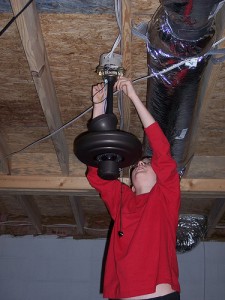





7 responses to “Is Asperger’s Left- or Right-Brained?”